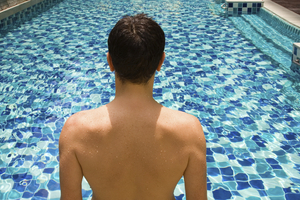SWIMMING: THE REFRESHING WAY TO STAY IN SHAPE
Many people have childhood memories of splashing in neighborhood pools or jumping in the ocean at a beach resort. However, most people don’t incorporate swimming into their exercise routine, even though it’s one of the few exercises that can improve all-around fitness. Whether doing laps in a local club or taking a dip in an area lake, swimming can help both beginners and experts boost strength, stamina, and flexibility all at the same time. Best of all, it’s a life skill that opens up a world of fun water activities, such as snorkeling, scuba diving, canoeing and sailing.
Why should I swim?
Swimming offers the cardiovascular benefits of running and some of the strength-building results of weight training because it uses all the major muscle groups. According to the World Federation of Hemophilia (WFH), swimming helps keep your joints flexible— especially in the neck, shoulders, hips and groin— as your limbs and body move through the water. Swimming is highly recommended for most people with hemophilia because it carries a much lower risk of injury than most contact sports (e.g. hockey, boxing, and football.) In addition, many studies have shown that swimming improves psychological well-being and significantly reduces tension and depression.
How much should I swim?
The recommended frequency of exercise for adults is 30 minutes at least five times a week. Swimming maximizes your fitness outcomes, as it burns up to 350 calories in only half an hour. And, because water is approximately 800 times denser than air, you can work harder in a pool than on land. However, it is important to be trained in correct stroke technique if you are planning to swim on a regular and/or competitive basis. Joint stress is directly related to the intensity and duration of a swim session, so be sure to build up your swimming distance gradually and use proper stroke techniques.
Is it too late to learn to swim?
Many adults are embarrassed that they can’t swim and, therefore, never attempt to learn. However, knowing how to swim is a must. Not only is swimming a skill that could ultimately save your or your child’s life, it’s something you will be able to use even as you get older. No matter what your age, weight or physical ability, learning to swim will fill you with a newfound confidence and sense of accomplishment. So be sure to contact your local pool or fitness club to ask about adult beginner classes. If you’re still unsure about starting lessons after you’ve researched dates, times and prices, ask if you can speak with one of the instructors or observe a class.
Any tips for beginners?
In addition to choosing a comfortable swimsuit, try wearing goggles. They let you keep your eyes wide open and aid relaxation in the water. Many clubs also encourage you to wear a swim cap and to rinse off in the shower before getting in the pool. When entering the water, never dive, jump, or push off the wall into oncoming swimmers. And, if you plan on swimming laps, keep in mind that most pools have slow, medium, and fast lanes, so choose one compatible with your speed. At all times, be aware of what is going on within your lane, and try not to kick or swing your arms into another swimmer’s path.
Why don’t people swim more?
Sure, you go swimming when you’re on vacation, but perhaps it seems too monotonous to incorporate swimming into your weekly routine. This isn’t true. Local clubs and community pools offer more than swimming endless laps. Many clubs now have a variety of water-based fitness classes, such as aqua aerobics and aqua jogging, and lessons for advanced swimmers focused on new strokes. The backstroke, breaststroke and butterfly all challenge different muscle groups in the body, so you can build strength while keeping your routine fresh. Joining a club or taking lessons are also great ways to meet new people in your community.
Where can I swim?
Local clubs or community pools are likely the most convenient option for most people. Swimming outside is an alternative if you live near a body of water. Before taking the plunge in a nearby lake, river or ocean, however, research the water quality online, and be aware of tides, currents, rocks and local sea-life. Some other safety precautions include swimming with a friend (either in the water or with him or her watching on shore), wearing a bright coloured swim cap so boats can see you and using a wetsuit if the water is cold.
Whether you choose an indoor pool or a natural body of water, it’s likely that you’ll ask yourself why you didn’t take up swimming sooner. Swimming is a life skill that can help almost anyone stay in shape, meet new friends, and feel great. So what’s stopping you?
You should consult your physician or other healthcare professional before starting any new physical activity









